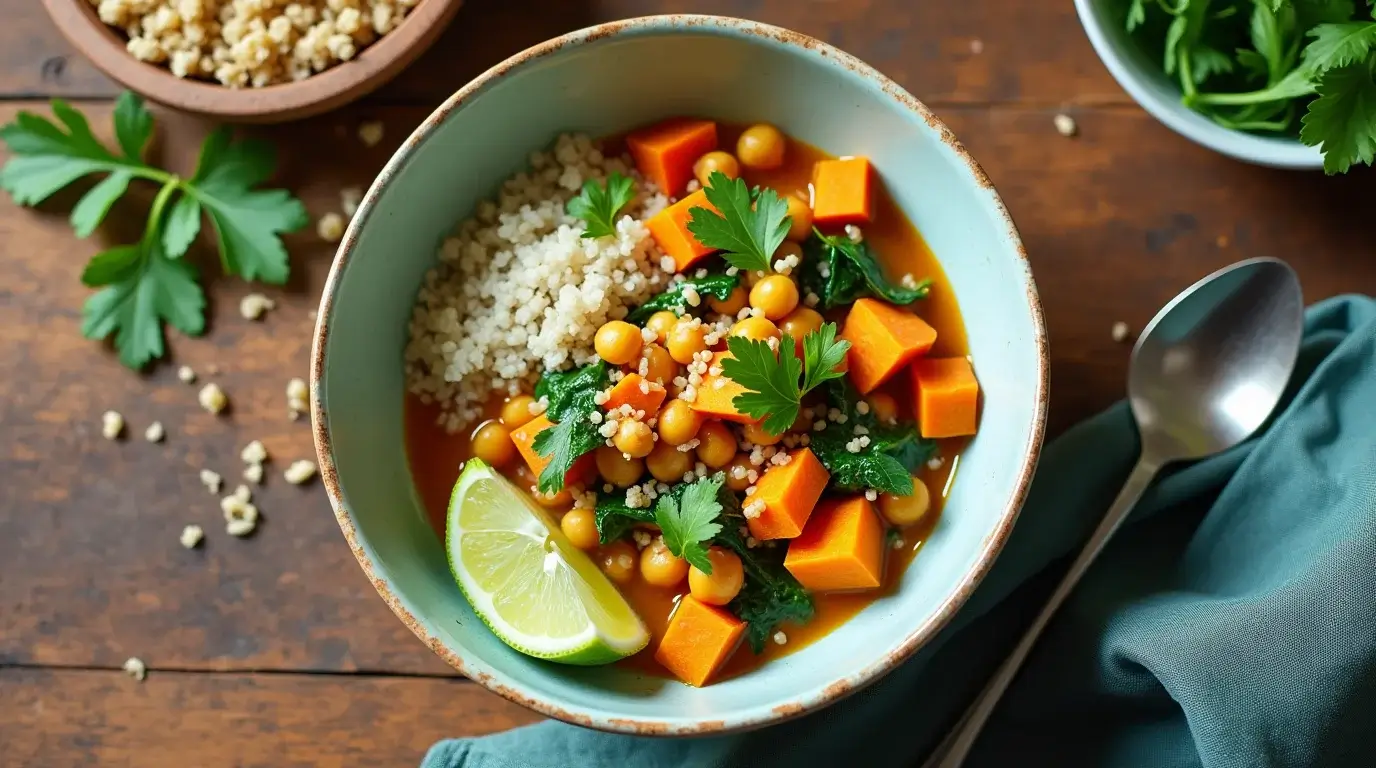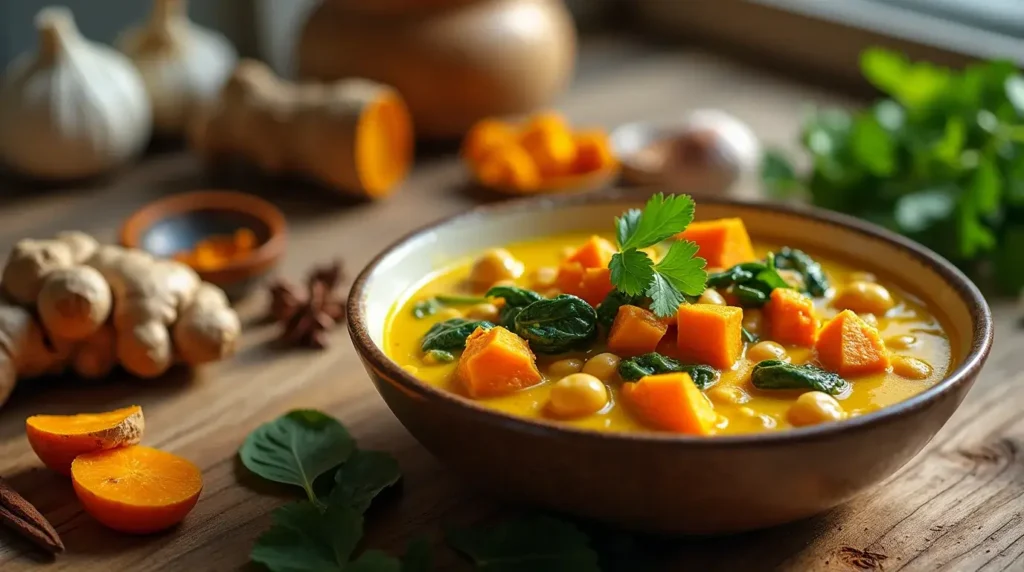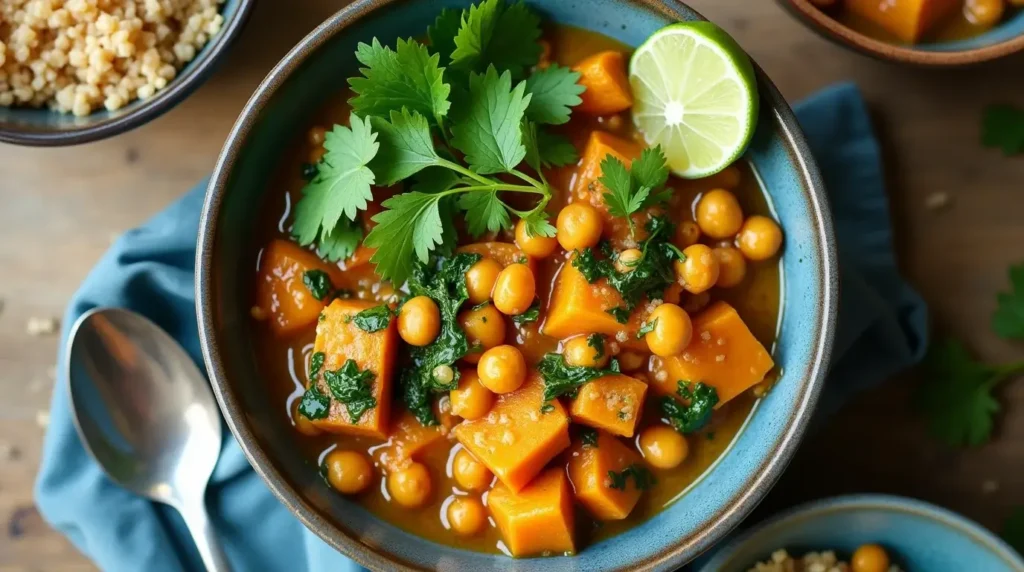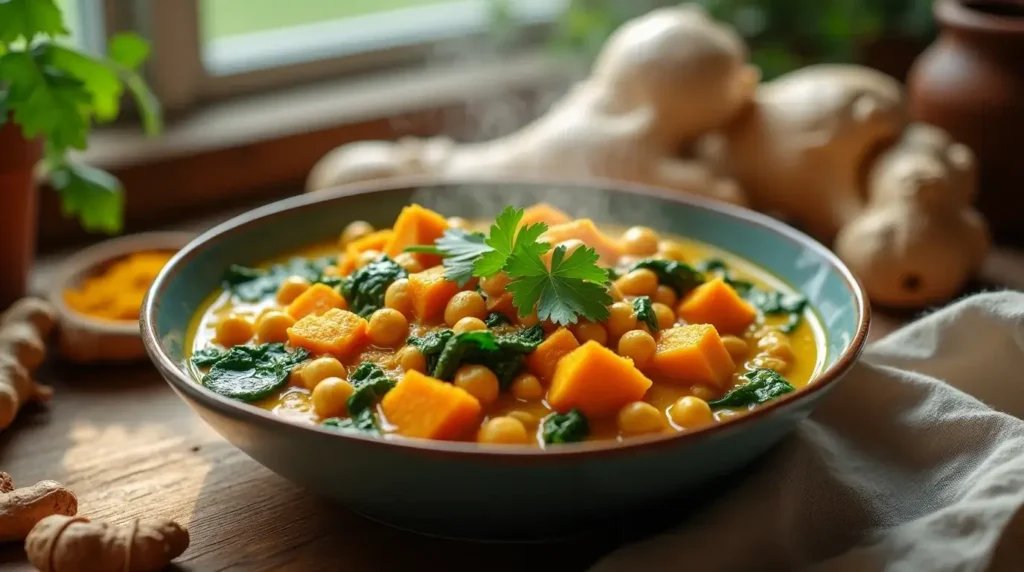Introduction and Nutrition
Starting the day with a nutritious breakfast sets the tone for energy, focus, and overall well-being throughout the day. While traditional breakfast options like cereal or toast might be quick fixes, they often lack the balance of nutrients needed to sustain energy and keep hunger at bay. This is where the concept of a breakfast curry comes into play—a delightful fusion of flavor and health.
Breakfast curries offer a creative and hearty way to start your morning, combining protein, fiber-rich vegetables, and aromatic spices like turmeric and ginger, known for their numerous health benefits. Whether you’re looking for a plant-based option, a high-protein meal, or a way to spice up your breakfast routine, this dish has something for everyone. Perfect for busy mornings or meal prepping ahead, a healthy breakfast curry is a versatile, satisfying, and energizing choice to fuel your day.
Why Choose a Breakfast Curry?
Breakfast curry stands out as a nutritious and flavorful alternative to traditional breakfast options like cereal, toast, or pastries. Unlike these carb-heavy choices that can lead to mid-morning energy crashes, breakfast curries are packed with nutrient-dense ingredients that provide sustained energy and a variety of health benefits.
The spices used in curries—such as turmeric, cumin, and ginger—offer incredible health advantages. Turmeric is a powerful anti-inflammatory spice that supports joint health and boosts immunity, while cumin aids digestion and enhances nutrient absorption. Ginger not only adds a zesty flavor but also promotes gut health and strengthens the immune system. Together, these spices create a dish that’s as healthy as it is delicious.
Another advantage of breakfast curry is its versatility. It can be easily customized to fit various dietary needs. For those following a vegan diet, ingredients like chickpeas, lentils, or tofu can provide plant-based protein. Gluten-free eaters can enjoy curries without worrying about hidden gluten. Additionally, you can tailor the dish to include seasonal vegetables, preferred protein sources, and even adjust spice levels to suit your taste. Whether you’re seeking a hearty, protein-packed start to the day or a light, veggie-filled breakfast, breakfast curry is a truly adaptable and nutritious choice.
Nutritional Benefits of Curry Ingredients
A healthy breakfast curry is a powerhouse of nutrition, thanks to its wholesome ingredients that offer numerous health benefits while providing sustained energy to fuel your day. Here’s a breakdown of some common ingredients used in breakfast curries and how they contribute to overall well-being:
1. Turmeric:
Known as a superfood, turmeric is prized for its potent anti-inflammatory and antioxidant properties. Its active compound, curcumin, helps reduce inflammation, improve joint health, and support brain function. Incorporating turmeric into your breakfast curry can enhance your body’s ability to fight off inflammation-related diseases and improve long-term health.
2. Ginger:
Ginger adds a zesty kick to curry while offering digestive and immune-boosting benefits. It aids in reducing nausea, improving gut health, and alleviating bloating. Its antibacterial properties help strengthen the immune system, making it an excellent addition to a morning meal.
3. Vegetables:
Curry is the perfect way to incorporate a variety of vegetables into your diet. Veggies like spinach, bell peppers, sweet potatoes, and tomatoes are rich in fiber, vitamins (A, C, and K), and minerals (iron and potassium). They promote healthy digestion, enhance immunity, and support heart health.
4. Protein Sources:
A healthy breakfast curry can include eggs, tofu, or lentils as protein sources. Eggs are rich in high-quality protein and essential nutrients like choline, which supports brain health. Tofu and lentils are excellent plant-based protein options that are low in fat and high in fiber, keeping you full and energized.
When combined, these ingredients provide a balanced mix of macronutrients and micronutrients, ensuring sustained energy and promoting overall health. A breakfast curry isn’t just flavorful—it’s a nutrient-packed meal to jumpstart your day.
Top 3 Healthy Breakfast Curry Variations
A breakfast curry is not just a flavorful start to your day; it’s also incredibly versatile, allowing you to experiment with ingredients to suit your taste and dietary needs. Below are three healthy and delicious breakfast curry variations, complete with key ingredients, step-by-step instructions, and tips for customization.
1. Vegetarian Breakfast Curry
Key Ingredients: Sweet potatoes, spinach, chickpeas, onion, garlic, ginger, turmeric, cumin, and vegetable stock.
Step-by-Step Guide:
- Prep the ingredients: Peel and dice sweet potatoes, rinse chickpeas, and roughly chop fresh spinach.
- Cook the base: Heat a drizzle of olive oil in a pan. Sauté diced onion, minced garlic, and grated ginger until fragrant. Add turmeric, cumin, and a pinch of salt to enhance the aroma.
- Add sweet potatoes and chickpeas: Stir in diced sweet potatoes and chickpeas. Add a splash of vegetable stock, cover, and simmer for 10–15 minutes, or until the sweet potatoes are tender.
- Finish with spinach: Stir in fresh spinach and cook until wilted. Adjust seasoning to taste.
- Serve and enjoy: Pair with whole-grain bread or brown rice for a hearty, fiber-rich breakfast.
2. High-Protein Breakfast Curry
Key Ingredients: Scrambled eggs, cooked quinoa, red lentils, diced tomatoes, onion, turmeric, curry powder, and garlic.
Tips for Maximizing Protein Content:
- Incorporate both plant-based and animal-based proteins for a balanced meal.
- Use quinoa as the base instead of rice, as it’s higher in protein and contains all nine essential amino acids.
Step-by-Step Guide:
- Cook the red lentils: Rinse lentils thoroughly and cook them in water or vegetable stock until tender. Set aside.
- Prepare the curry base: Heat oil in a skillet and sauté diced onions and garlic. Add curry powder, turmeric, and diced tomatoes to create a thick, flavorful base.
- Add protein components: Stir in cooked lentils and quinoa, mixing well with the curry sauce. Scramble eggs in a separate pan and fold them into the mixture.
- Adjust flavors and serve: Add salt, pepper, or chili flakes to taste. Garnish with fresh cilantro and serve warm.
3. Vegan Coconut Curry for Breakfast
Key Ingredients: Coconut milk, kale, bell peppers, garlic, ginger, curry paste, and chickpeas.
Tips for Enhancing Flavors with Plant-Based Ingredients:
- Use full-fat coconut milk for a richer flavor and creamier texture.
- Add fresh lime juice or a dash of soy sauce to balance the sweetness of the coconut milk.
Step-by-Step Guide:
- Sauté the aromatics: Heat oil in a pan and sauté minced garlic and ginger. Stir in your favorite curry paste (red or yellow works well) for a bold base.
- Add the vegetables and chickpeas: Toss in chopped bell peppers, kale, and chickpeas. Cook for 5–7 minutes until the vegetables are tender but still vibrant.
- Simmer in coconut milk: Pour in coconut milk and simmer for 10 minutes, allowing the flavors to meld together.
- Adjust seasoning and serve: Season with salt, pepper, and a splash of lime juice. Pair with whole-grain naan or cooked quinoa for a satisfying vegan meal.
These three variations prove that breakfast curry can suit any lifestyle, from vegetarian to high-protein or fully plant-based. Not only are they packed with nutrients, but they also bring exciting flavors to your breakfast table!
Recipe Spotlight – Signature Healthy Breakfast Curry
Prep Time: 10 minutes
Cook Time: 20 minutes
Serving Size: 2 servings
Ingredients
- 1 tablespoon olive oil
- 1 small onion, finely diced
- 2 garlic cloves, minced
- 1 teaspoon grated ginger
- 1 teaspoon turmeric powder
- 1 teaspoon curry powder
- 1 cup diced sweet potatoes
- 1/2 cup cooked chickpeas (canned or pre-cooked)
- 1/2 cup coconut milk
- 1 cup fresh spinach leaves
- 1/2 cup diced tomatoes (fresh or canned)
- 1/4 cup vegetable stock or water
- Salt and pepper to taste
- Fresh cilantro for garnish
- Optional: Serve with brown rice, quinoa, or whole-grain bread
Cooking Instructions
- Prepare the base: Heat olive oil in a medium-sized skillet over medium heat. Add the diced onion and sauté until softened (about 3 minutes). Stir in the minced garlic and grated ginger, cooking until fragrant.
- Add the spices: Sprinkle in the turmeric and curry powder, stirring to coat the onions and release their aroma (1–2 minutes).
- Cook the vegetables: Add the diced sweet potatoes and chickpeas to the skillet. Pour in the vegetable stock, cover the skillet, and let simmer for 10–12 minutes, or until the sweet potatoes are tender.
- Incorporate the liquids: Stir in the coconut milk and diced tomatoes. Let the mixture simmer uncovered for another 5 minutes to allow the flavors to meld.
- Add the greens: Toss in the fresh spinach and stir until wilted (1–2 minutes). Season with salt and pepper to taste.
- Serve and enjoy: Garnish with fresh cilantro and serve warm with your choice of brown rice, quinoa, or whole-grain bread.
Tips for Batch Cooking and Substitutions
- Batch Cooking: Double the recipe and store portions in airtight containers in the refrigerator for up to 3 days or freeze for up to 2 months. Reheat gently on the stove or in the microwave.
- Substitutions:
- Swap sweet potatoes for butternut squash or carrots.
- Use kale or Swiss chard in place of spinach.
- Add a sprinkle of chili flakes for extra heat or a squeeze of lime for a zesty finish.
This signature healthy breakfast curry is perfect for busy mornings and meal prep, offering a flavorful and nutritious start to your day!
Tips for Making Your Breakfast Curry Healthy and Delicious
Making a breakfast curry that’s both healthy and delicious requires a thoughtful approach to ingredients, flavors, and preparation. Here are some practical tips to elevate your breakfast curry while keeping it nutritious.
Choosing the Right Oil for Cooking
The type of oil you use can significantly impact the nutritional profile of your curry. Olive oil is a heart-healthy choice, rich in monounsaturated fats and antioxidants, making it great for sautéing at medium heat. For a more traditional flavor, coconut oil is a fantastic alternative. While it’s higher in saturated fat, coconut oil is often praised for its ability to add richness and depth to curries. Use it in moderation to enjoy its benefits without overdoing the calories.
Balancing Spices for Flavor
Spices are the cornerstone of a good curry, but balance is key. Use a mix of spices like turmeric, cumin, coriander, and curry powder for depth without overwhelming the dish. Start with small amounts and adjust to your taste as you cook. A squeeze of fresh lime juice or a sprinkle of fresh herbs like cilantro at the end can brighten the dish and balance out richer flavors.
Incorporating Seasonal Vegetables
Seasonal vegetables not only taste fresher but also provide optimal nutrition. In summer, use zucchini, bell peppers, or tomatoes, while winter is perfect for sweet potatoes, kale, or butternut squash. Rotating vegetables ensures variety and helps you take advantage of local, in-season produce.
Portion Control for a Balanced Breakfast
While curries are packed with nutrients, portion size is crucial to avoid overindulging. Aim for a balance of protein, vegetables, and a modest serving of whole grains like quinoa, brown rice, or whole-grain bread. Stick to one cup of curry per serving, complemented by a small portion of your chosen side, to keep your breakfast filling yet light.
By focusing on high-quality ingredients, balanced flavors, and mindful portions, you can create a breakfast curry that’s both nourishing and satisfying, setting the tone for a healthy day ahead.
Quick Breakfast Curry Hacks for Busy Mornings
Breakfast curry can still be a part of your routine even on busy mornings with a few simple hacks to save time and effort. Here are some tips to make the process faster and more convenient while maintaining flavor and nutrition.
Pre-Chopping Ingredients or Using Frozen Vegetables
Prepping your ingredients in advance can make cooking a breeze. Chop vegetables like sweet potatoes, bell peppers, or onions the night before and store them in airtight containers in the fridge. For an even quicker option, use frozen vegetables like spinach, peas, or pre-cut mixed vegetables. They’re just as nutritious as fresh produce and eliminate the need for peeling and chopping, saving you precious time.
One-Pot Curry Recipes for Easy Cleanup
Minimize cleanup by preparing your breakfast curry in a single pot or skillet. Sauté your aromatics (onions, garlic, and spices), add your vegetables, protein, and liquid ingredients, then let everything simmer together. This method not only reduces dishes but also enhances the flavors as the ingredients cook together in one vessel.
Reheating Leftovers Without Compromising Taste
Make a larger batch of curry and store leftovers in airtight containers. Reheat portions gently on the stovetop or in the microwave, adding a splash of water or coconut milk to restore the creamy consistency. To keep the flavors fresh, garnish with chopped herbs or a squeeze of lime just before serving.
These simple hacks ensure you can enjoy a warm, flavorful, and nutritious breakfast curry even on the busiest mornings!
FAQs About Breakfast Curry Recipes
Is curry good for breakfast?
Yes, curry can be an excellent choice for breakfast! It’s a flavorful way to incorporate a variety of nutrients, including protein, fiber, and vitamins, to fuel your day. Spices like turmeric and ginger not only enhance flavor but also provide health benefits such as improved digestion and reduced inflammation. Plus, a breakfast curry is highly customizable, allowing you to tailor it to your dietary preferences and nutritional needs.
What is the healthiest curry dish?
The healthiest curry dishes are those packed with vegetables, lean proteins, and light sauces. A great example is a vegetable curry made with coconut milk or tomato-based sauces, chickpeas, spinach, and spices like turmeric. Dishes like lentil dal or a vegan coconut curry are low in saturated fat and rich in fiber, making them wholesome and nutritious.
What’s the most filling healthy breakfast?
A breakfast that includes a balance of protein, healthy fats, and fiber is the most filling. Breakfast curry fits the bill, especially when paired with whole grains like quinoa or brown rice. Ingredients like eggs, lentils, tofu, or chickpeas provide protein, while vegetables and spices add fiber and flavor, keeping you satisfied for hours.
Can curry be healthy?
Absolutely! Curry can be very healthy when prepared with nutritious ingredients. Spices such as turmeric and cumin offer anti-inflammatory and antioxidant benefits, while vegetables provide essential vitamins and minerals. To make it even healthier, use minimal oil and avoid cream-based sauces by opting for lighter alternatives like coconut milk or tomato-based curries.
What are 3 healthy breakfast foods?
- Breakfast curry with vegetables, chickpeas, or eggs.
- Overnight oats topped with fresh fruits and nuts.
- Smoothies made with leafy greens, fruits, and protein-rich additions like yogurt or almond butter.
Can I eat curry every day?
Yes, you can eat curry every day if it’s balanced and prepared healthily. Stick to curries with plenty of vegetables, lean proteins, and spices while limiting heavy cream, fried components, and excess salt. Eating a variety of curries can help you incorporate diverse nutrients into your diet.
Is curry healthy for weight loss?
Curry can be a great addition to a weight-loss diet if made with low-calorie, nutrient-dense ingredients. A vegetable or lentil curry with minimal oil and paired with a portion-controlled serving of quinoa or brown rice can support your goals by keeping you full and reducing cravings.
Which curry is the least fattening?
The least fattening curries are those with tomato-based sauces, such as a vegetable curry or lentil dal. These are low in calories and fat compared to cream- or butter-based curries like korma or tikka masala. Pair with steamed vegetables or a small portion of whole grains for a balanced meal.
Is curry more fattening than pizza?
This depends on how the curry and pizza are prepared. A veggie-filled curry with a light sauce and whole grains is typically less fattening than a cheese-loaded pizza with refined crust. However, rich curries with creamy sauces can rival or exceed pizza in calorie content. To keep curry lighter, opt for plant-based ingredients and avoid heavy fats.
Conclusion
Incorporating a healthy breakfast curry into your morning routine is a flavorful and nutritious way to kickstart your day. Packed with wholesome ingredients like protein-rich legumes, fiber-filled vegetables, and antioxidant-laden spices, breakfast curries offer a balanced meal that provides sustained energy, improves digestion, and supports overall health. Unlike traditional breakfast options, they are incredibly versatile and can be tailored to suit a variety of dietary preferences, including vegan, vegetarian, or high-protein diets.
One of the greatest joys of making breakfast curry is the freedom to experiment with ingredients and flavors. From seasonal vegetables to your choice of protein, the possibilities are endless. You can adjust spice levels to suit your taste or explore different combinations of herbs and seasonings to keep things exciting. With batch cooking and meal prep, breakfast curry also offers a convenient, time-saving solution for busy mornings.
By embracing breakfast curry, you’ll transform your mornings into a celebration of health and taste. Whether you’re savoring a vegan coconut curry, a protein-packed egg curry, or a hearty sweet potato and chickpea variation, you’re treating yourself to a meal that nourishes your body and satisfies your palate. Start your day with a bowl of warm, aromatic goodness, and enjoy the lasting benefits of this delicious and nutrient-packed dish.
Print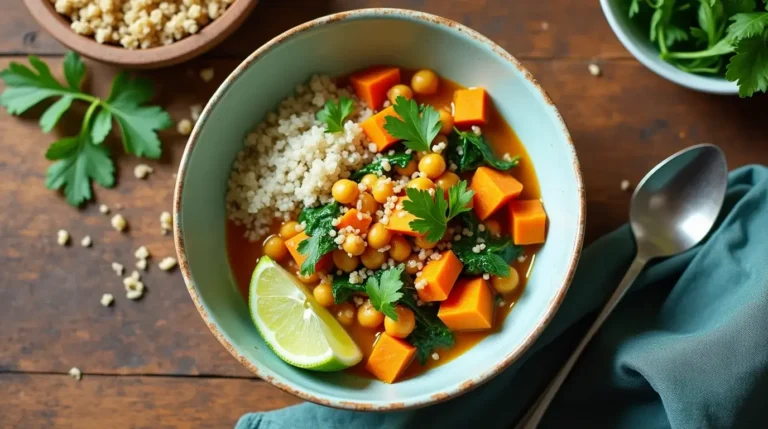
Healthy Breakfast Curry Recipe for a Nutritious Morning
A warm, flavorful, and healthy breakfast curry recipe featuring sweet potatoes, spinach, and chickpeas simmered in a creamy coconut milk base. Perfect for a nutritious start to the day or meal prep for busy mornings.
- Total Time: 30 minutes
- Yield: 2 servings 1x
Ingredients
- 1 tablespoon olive oil
- 1 small onion, finely diced
- 2 garlic cloves, minced
- 1 teaspoon grated ginger
- 1 teaspoon turmeric powder
- 1 teaspoon curry powder
- 1 cup diced sweet potatoes
- 1/2 cup cooked chickpeas (canned or pre-cooked)
- 1/2 cup coconut milk
- 1 cup fresh spinach leaves
- 1/2 cup diced tomatoes (fresh or canned)
- 1/4 cup vegetable stock or water
- Salt and pepper to taste
- Fresh cilantro for garnish
- Optional: Brown rice, quinoa, or whole-grain bread for serving
Instructions
- Heat olive oil in a medium skillet over medium heat. Add diced onion and sauté until softened, about 3 minutes.
- Stir in minced garlic and grated ginger. Cook for 1 minute until fragrant.
- Add turmeric powder and curry powder, stirring to coat the onions and release their aroma.
- Add diced sweet potatoes and chickpeas. Pour in the vegetable stock, cover, and simmer for 10–12 minutes or until the sweet potatoes are tender.
- Stir in the coconut milk and diced tomatoes. Simmer uncovered for 5 minutes, allowing the flavors to meld.
- Toss in the fresh spinach and stir until wilted, about 1–2 minutes.
- Season with salt and pepper to taste. Garnish with fresh cilantro and serve warm with brown rice, quinoa, or whole-grain bread.
Notes
- Batch Cooking: Double the recipe and store portions in airtight containers in the fridge for up to 3 days or freeze for up to 2 months.
- Substitutions: Swap sweet potatoes for butternut squash or carrots. Use kale instead of spinach for a slightly heartier texture.
- Spice Levels: Add chili flakes or fresh chili for a spicier curry.
- Prep Time: 10 minutes
- Cook Time: 20 minutes
- Category: Breakfast
- Method: Stovetop
- Cuisine: Fusion, Indian-inspired
- Diet: Vegetarian
Nutrition
- Serving Size: 1 bowl (with curry only, no sides)
- Calories: 230
- Sugar: 6g
- Sodium: 380mg
- Fat: 9g
- Saturated Fat: 4g
- Unsaturated Fat: 5g
- Trans Fat: 0g
- Carbohydrates: 30g
- Fiber: 8g
- Protein: 7g
- Cholesterol: 0mg
Keywords: Healthy breakfast curry, nutritious curry recipe, breakfast meal prep, turmeric curry recipe

